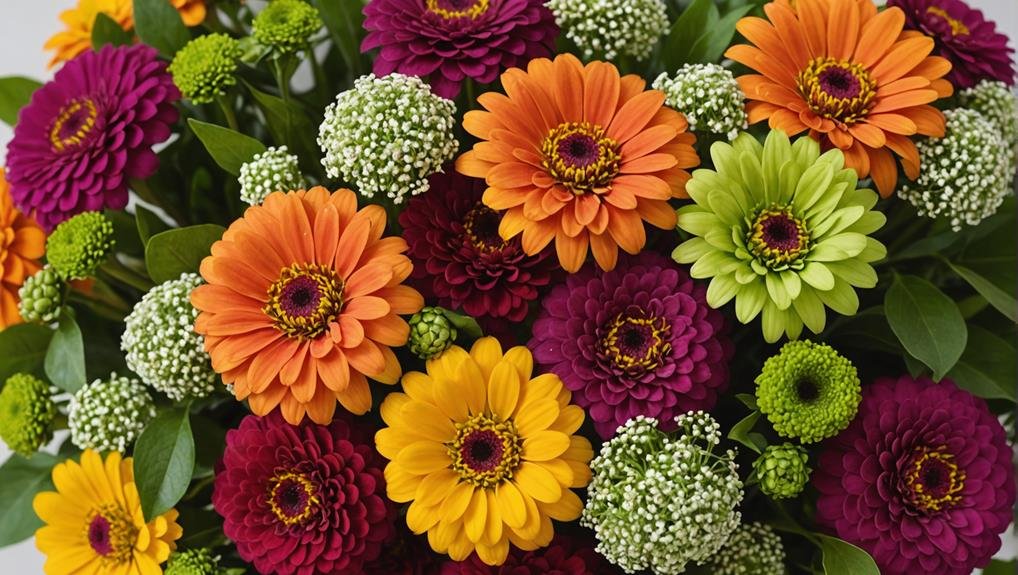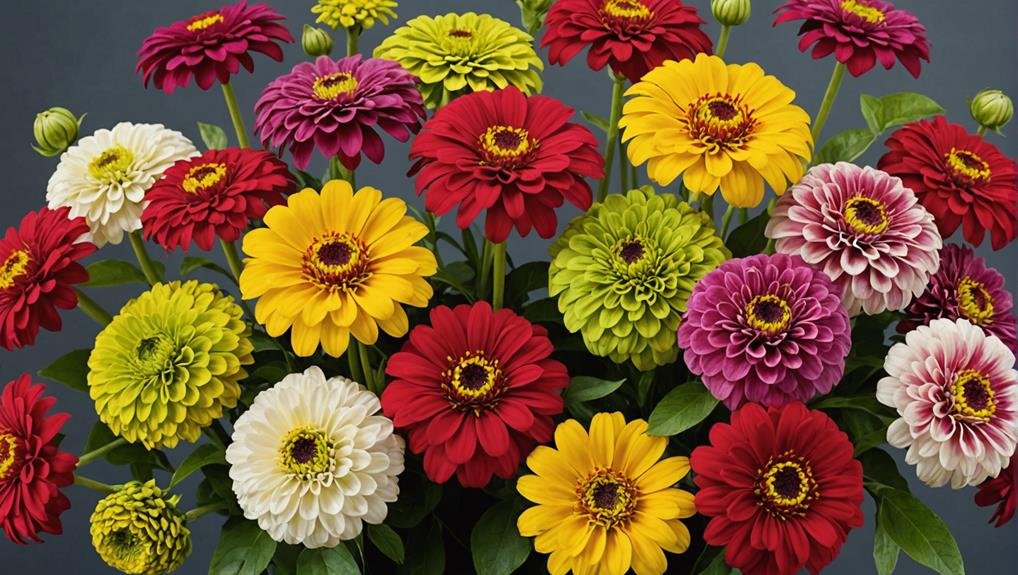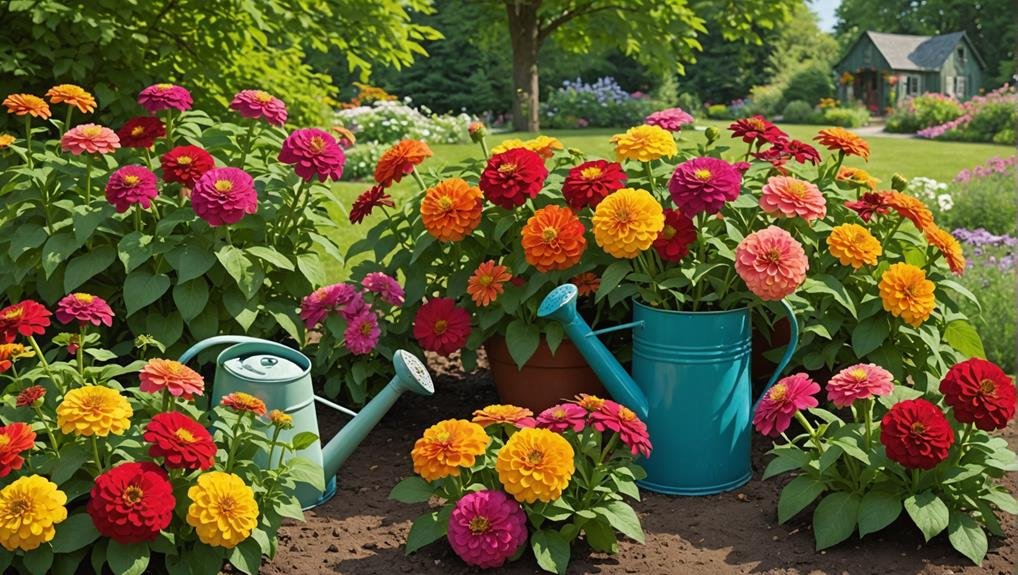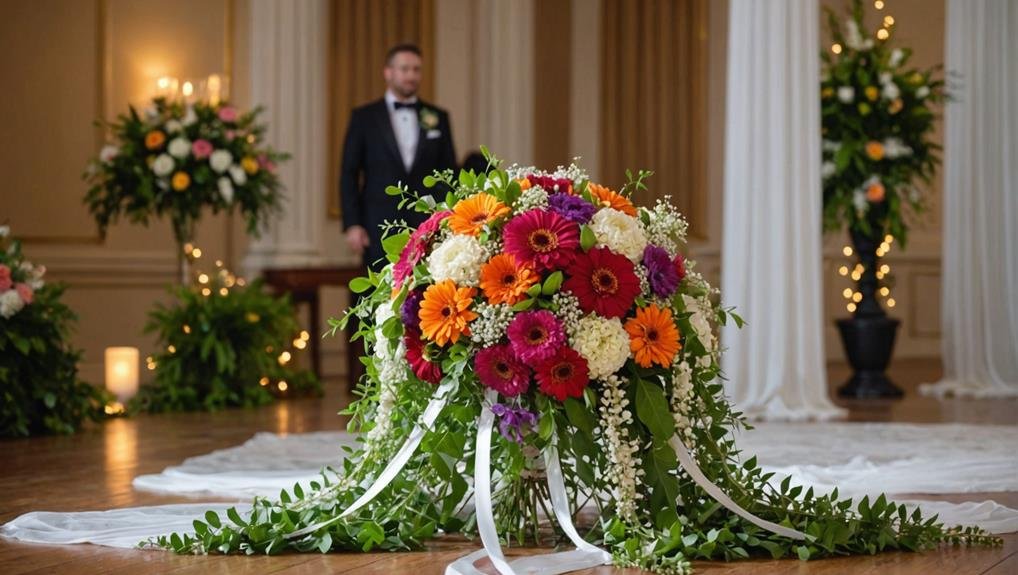Zinnias, with their vibrant hues and versatile nature, have become a favored choice for wedding florals, offering a striking balance of beauty and symbolism. Representing friendship, remembrance, and endurance, these annual blooms are more than just decorative elements; they carry profound meanings that can enhance the emotional resonance of wedding celebrations. Whether incorporated into bouquets, centerpieces, or other decor, zinnias provide a pop of color that can be tailored to any wedding theme. One might wonder, what makes zinnias particularly suited to wedding arrangements, and how do their characteristics compare to other popular floral choices?
Flower Overview

Zinnias are widely cherished cut flowers, renowned for their vibrant hues and impressive vase life of approximately five days. Their popularity in floral design is largely attributed to their striking colors and ability to symbolize friendship, remembrance, and endurance—qualities that make them an ideal choice for weddings and other special occasions.
A standout among zinnia varieties is the Queen Lime series, celebrated for its unique and alluring color palette that ranges from soft greens to deep reds. This series, along with the Oklahoma series, is highly sought after in local markets, providing a diverse range of options for floral designers aiming to create memorable and visually stunning arrangements.
Growing zinnias requires attention to specific conditions to ensure best blooms. These flowers thrive in full sun and well-draining soil, with the recommended spacing of 6-9 inches to allow for proper air circulation and growth.
Blooming from summer until the first frost, zinnias must be harvested early in the morning with deep cuts for longer stems. Keeping them in constant water is essential to maintaining their freshness and extending their vase life, making them a dependable choice for event decorations.
Physical Description
Bursting with vibrant colors and diverse forms, these annual flowering plants captivate with their varied shapes and sizes. Zinnias are renowned for their striking floral displays, making them a popular choice for wedding arrangements. The structural integrity of these flowers is supported by long, sturdy stems, which can hold up both single and double-petaled flower heads with ease. This feature is particularly advantageous for floral designers seeking to create elegant and enduring wedding bouquets and centerpieces.
The flower heads of zinnias exhibit a remarkable range in size and form. They can vary from small, button-like blooms to large, dahlia-like blossoms, ensuring versatility in floral designs. The petals are generally arranged in multiple layers, contributing to the flower’s full, lush appearance. This characteristic enhances the visual appeal and textural diversity in any floral arrangement.
Zinnias possess foliage that is generally lance-shaped and slightly coarse to the touch, providing a subtle contrast to the soft, vibrant petals. Specific varieties may even display a hint of lime in their foliage, adding a unique element to their overall aesthetic. These distinct physical attributes make zinnias an excellent choice for those seeking both beauty and functionality in wedding florals.
Available Colour Varieties

In addition to their diverse forms and structural appeal, the color varieties of zinnias further enhance their desirability for wedding floral arrangements. Zinnias are celebrated for their vibrant spectrum of colors, making them a versatile choice for various wedding themes and palettes.
Some of the most popular zinnia color varieties include:
- Queen Lime: This series is renowned for its unique chartreuse and lime shades, adding a distinctive touch to bouquets and centerpieces.
- Benary Giants: Known for their large blooms, these zinnias come in an array of colors, including pink, red, orange, yellow, and purple, offering diverse options for floral arrangements.
- Zinderella: Featuring double blooms with a playful frilled appearance, the Zinderella series includes charming colors like coral and dusty rose.
- Oklahoma Series: These zinnias are admired for their smaller, more delicate blooms available in a broad range of vibrant hues, perfect for adding texture and color to any arrangement.
The extensive color range of zinnias, from pure white to vibrant rainbow shades, coupled with their symbolic meanings of friendship, remembrance, and endurance, makes them an ideal and meaningful choice for wedding florals.
Latin Name and Taxonomy
The Latin name for zinnia, Zinnia elegans, honors the German botanist Johann Gottfried Zinn. Zinnia elegans is a prominent species within the genus Zinnia, which falls under the Asteraceae family. This family, also known as the daisy family, encompasses a wide range of well-known flowering plants, including daisies, sunflowers, and asters. The classification of Zinnia within this family indicates its shared characteristics with other members, such as its composite flower structure.
Johann Gottfried Zinn, after whom the genus is named, made significant contributions to botany, particularly in the study of plant anatomy and taxonomy. His work laid the foundation for naming this vibrant and diverse group of flowers. The genus Zinnia encompasses approximately 20 species of both annual and perennial plants, each exhibiting a variety of forms and colors.
Among these species, Zinnia elegans stands out as the most commonly cultivated due to its strikingly vibrant flowers, which are highly favored in gardens and floral arrangements. Its taxonomic classification within the Asteraceae family and its historical association with Johann Gottfried Zinn highlight the botanical and cultural significance of this beloved flower.
Geographical Origins

Originating in the balmy regions of Central America, zinnias were first cultivated by the Aztecs, showcasing their deep-seated historical presence in Mexico. These lively flowers have a rich history and have adapted remarkably well to various environments. The geographical roots of zinnias underscore their resilience and versatility, making them a favored choice for gardens and wedding arrangements.
In the 18th century, zinnias made their way to Europe, thanks to the efforts of botanists who recognized their potential. Johann Gottfried Zinn, a German botanist, played a significant role in this transformation, lending his name to the plant as a tribute to its scientific importance. The journey of zinnias from their native lands to global prominence is a proof of their adaptability and appeal.
To summarize the key points about the geographical origins of zinnias:
- Native to Mexico: First cultivated by the Aztecs, highlighting their historical origins.
- Brought to Europe: Introduce in the 18th century, gaining popularity as garden and cut flowers.
- Named after Johann Gottfried Zinn: A German botanist who contributed to their recognition.
- Thrives in warm climates: Adaptable to regions with ample sunlight and well-draining soil.
These elements highlight the rich geographical history and enduring appeal of zinnias.
Season Availability
Despite their tropical origins, zinnias flourish mainly during the summer and fall seasons, making them an ideal choice for weddings scheduled in these warmer months. This seasonal availability guarantees that these beautiful zinnias are at their peak, offering vibrant and colorful blooms that can enhance any wedding décor. Their ability to bloom profusely during these periods assures a plentiful supply, allowing couples to enjoy stunning floral arrangements that last season long.
One of the standout features of zinnias is their long vase life. This characteristic makes them particularly suitable for wedding decorations and bouquets that need to maintain their beauty throughout the entire celebration. Whether it’s for centerpieces, bridal bouquets, or decorative arrangements, zinnias provide a dependable option for enduring freshness.
Moreover, the diverse range of colors and varieties available in zinnias allows for a perfect match to any wedding color scheme or theme. From bold reds to soft pastels, the versatility of zinnias can cater to various aesthetic preferences.
In addition to their visual appeal, zinnias are a cost-effective choice. Their affordability enables couples to create extravagant floral displays without compromising their budget, making zinnias a popular option for growing cut flowers in wedding planning.
Growing Conditions

Optimizing ideal growth for zinnias necessitates full sun exposure and well-draining soil, with appropriate plant spacing of 6-9 inches. Zinnias, including the stunning Queen Red Lime variety, flourish under these conditions, producing vibrant and abundant blooms. These gorgeous zinnias are easy to grow, making them a popular choice for gardeners and florists alike.
To achieve best results, consider the following key factors:
- Sunlight: Zinnias require at least six hours of direct sunlight daily. Insufficient light can lead to leggy plants and fewer blooms.
- Soil: Well-draining soil is vital to prevent root rot. Amend heavy soils with organic matter to improve drainage.
- Watering: Regular watering is essential, particularly during dry spells. However, avoid overhead watering to reduce the risk of foliar diseases.
- Temperature: Zinnias are highly sensitive to frost. Plant them after the last frost date in your area and optimize they are harvested before temperatures drop below 45°F.
Proper care and maintenance are crucial to ward off common issues such as zinnia meltdown and pests like earwigs, beetles, aphids, and mites. By adhering to these guidelines, you can optimize your zinnias thrive, adding beauty and elegance to any wedding arrangement.
Cultural Significance
Zinnias hold significant cultural value in wedding ceremonies, symbolizing friendship, remembrance, and endurance through their vibrant and lasting blooms. These attributes make zinnias a meaningful choice for wedding bouquets and floral designs, adding depth to the aesthetic and emotional narrative of the event. The vibrant colors of zinnias, ranging from soft pastels to bold hues, not only enhance the visual appeal but also convey joy and happiness, essential elements for any wedding celebration.
Incorporating zinnias into wedding bouquets and other floral arrangements speaks to their cultural significance. Their enduring nature represents the strength and longevity of the marital bond, while their symbolism of friendship underscores the companionship and support that are foundational to a successful marriage. Additionally, zinnias’ capacity to retain their beauty over time aligns with the concept of lasting love and commitment.
Zinnias’ versatility in floral designs allows them to seamlessly blend into various wedding themes and styles. Whether used in rustic, garden, or modern settings, these flowers complement different color palettes and decor schemes. Their ability to adapt to diverse arrangements—from elegant bouquets to charming centerpieces—makes them a favored choice for couples seeking to infuse their wedding with symbolic meaning and aesthetic charm.
Typical Use in Weddings

In wedding ceremonies, zinnias are frequently chosen for their vibrant colors, long-lasting freshness, and adaptability in various floral arrangements. These flowers offer a wide array of hues and sizes, making them ideal for customizing wedding decor to match any theme. Among the varieties, Queen Lime Orange stands out for its unique and elegant shade, adding a sophisticated touch to any celebration.
Gorgeous Zinnias are particularly favored in bridal bouquets, where their bold appearance can serve as stunning focal flowers. Additionally, they are often incorporated into various wedding decor elements due to their versatility.
Here are four typical uses of zinnias in weddings:
- Bridal Bouquets: Zinnias provide a striking focal point, especially when combined with complementary blooms.
- Centerpieces: Their vibrant colors and long vase life make zinnias perfect for eye-catching table arrangements.
- Floral Arches: These flowers can be used to adorn ceremonial arches, adding a burst of color and texture.
- Aisle Decorations: Zinnias can line the aisle in pots or arrangements, creating a picturesque pathway for the bride’s entrance.
Their symbolism of friendship, remembrance, and endurance further enhances their appeal, making zinnias a meaningful and budget-friendly choice for weddings.
Alternative Flower Types
When planning a wedding, considering alternative flower types such as dahlias, marigolds, and sunflowers can provide a unique and vibrant touch to your floral arrangements. These blooms not only add a burst of color but also introduce diverse textures, enhancing the overall aesthetic of your wedding decor.
Exploring alternative flower types like cosmos, celosia, and lisianthus can further diversify your floral arrangements, offering a range of hues and shapes that complement various wedding themes. Cosmos, with their delicate petals, bring an airy elegance, while marigolds add a rich, warm tone that can brighten any bouquet.
Incorporating daisies, lilies, and asters as alternatives to zinnias can create interesting contrasts in texture and form. Daisies offer a simple charm, lilies exude sophistication, and asters contribute a whimsical touch.
For a more refined look, consider unique blooms such as ranunculus, peonies, and anemones. These flowers are known for their lush, layered petals and can elevate the elegance of your arrangements.
For those seeking a more exotic flair, flowers like protea, orchids, and bird of paradise provide striking, tropical elements that can transform your wedding into an unforgettable visual experience. By experimenting with these alternative flower types, you can craft a truly personalized and memorable floral display.
